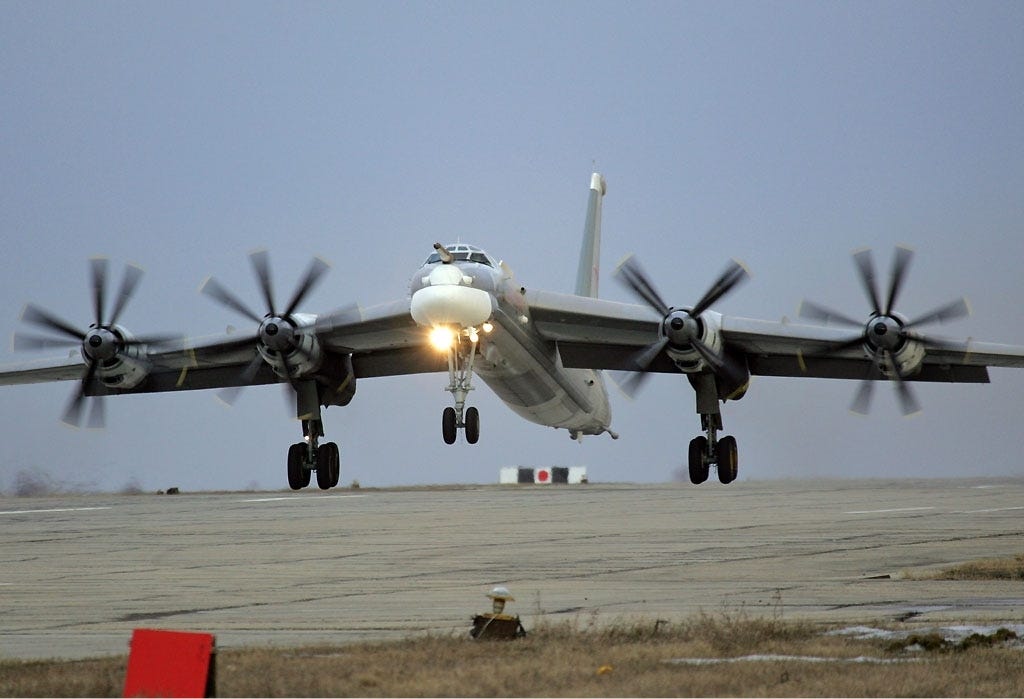| Tu-95LAL | |
|---|---|
| The Tu-95LAL test aircraft. The bulge in the fuselage aft of the wing covers the reactor. | |
| Role | Experimental nuclear aircraft |
| Manufacturer | Tupolev |
| First flight | 1961 |
| Number built | 1 |
| Developed from | Tupolev Tu-95 |
'White Swan'; NATO reporting name: Blackjack) is a supersonic, variable-sweep wing heavy strategic bomber designed by the Tupolev Design Bureau in the Soviet Union. It is the largest and heaviest Mach 2+ supersonic military aircraft ever built and second only to the XB-70 Valkyrie in overall length. Dec 09, 2014 They are the most famous representatives of Tupolev military aircrafts. Strategic bomber aircraft Tu-95 “Atomic Bear” Strategic (intercontinental) bomber completed its first flight in 1952. In 1955 serial production of the aircraft began. Over the past decades, the aircraft was repeatedly modified and upgraded. The aircraft is still today is in service of the Russian. A newly built Tupolev Tu-160 long-range heavy strategic bomber – the first one since 1992 – was rolled out of the hangar as Russia resumes production of the world’s largest operational bomber that NATO designates as Blackjack.
The Tupolev Tu-95LAL, (Russian: Летающая Атомная Лаборатория, romanized: Letayushchaya Atomnaya Laboratoriya, lit.'flying atomic laboratory'), was an experimental aircraft that was a modified Tupolev Tu-95 Soviet bomber aircraft, which flew from 1961 to 1965, analogous to the United States' earlier Convair NB-36H. It was intended to see whether a nuclear reactor could be used to power an aircraft, primarily testing airborne operation of a reactor and shielding for components and crew.
- 5References
Description[edit]
During the Cold War the USSR had an experimental nuclear aircraft program. Without the need to refuel, a nuclear-powered aircraft would have greatly extended range compared to conventional designs.[1]
On 12 August 1955 the Council of Ministers of the USSR issued a directive ordering bomber-related design bureaus to join forces in researching nuclear aircraft. The design bureaus of Andrei Tupolev and Vladimir Myasishchev became the chief design teams, while N. D. Kuznetsov and A. M. Lyulka were assigned to develop the engines. They chose to focus on the direct-cycle system from the start, testing ramjets, jet engines and even turboprops.[1]

The Tupolev bureau, knowing the complexity of the task assigned to them, estimated that it would be two decades before the program could produce a working prototype. They assumed that the first operational nuclear-assisted airplane could take to the air in the late 1970s or early 1980s. In order to gain experience with operational problems, they proposed building a flying testbed as soon as possible, mounting a small reactor in a Tupolev Tu-95M to create the Tu-95LAL.[1][2]
The VVRL-lOO reactor was fitted in the bomb bay of the aircraft, requiring aerodynamic fairings over the top and bottom. From 1961 to 1969, the Tu-95LAL completed over 40 research flights.[3] Most of these were made with the reactor shut down. The main purpose of the flight phase was examining the effectiveness of the radiation shielding, which was one of the main concerns for the engineers. Liquid sodium, beryllium oxide, cadmium, paraffin wax and steel plates were used for protection. The shielding efficiency is disputed: most sources say that it was at least efficient enough to warrant further work,[1][2][4] and indeed, the design of the follow-up prototype, the Tu-119, was started.[4]
As in the US, development was curtailed on grounds of cost and environmental concerns. The emerging potential of the intercontinental ballistic missiles made the expensive nuclear aircraft program superfluous, and it was scaled back.[1]
Tu-119[edit]
The next stage in the development of a nuclear-powered bomber would have been the Tupolev Tu-119, a modified Tu-95, which would have been powered by both nuclear-fuelled and kerosene-fuelled turboprop engines: two Kuznetsov NK-14A nuclear-fuelled engines inboard, fed with heat from a fuselage-mounted reactor and two kerosene-fed Kuznetsov NK-12 turboprops outboard. The Tu-119 was never completed due to the nuclear-powered bomber project being cancelled on grounds of cost and the dire environmental impact of possible mishaps and accidents.[1]
Specifications (Tu-95LAL)[edit]
Note: the specifications given are those of the Tu-95MS, which were identical to the Tu-95LAL.
Data from Combat Aircraft since 1945[5]
General characteristics
- Length: 46.2 m (151 ft 7 in) [6]
- Wingspan: 50.1 m (164 ft 4 in) [6]
- Height: 12.12 m (39 ft 9 in)
- Wing area: 310 m2 (3,300 sq ft)
- Gross weight: 145,000 kg (319,670 lb)
- Landing weight: 110,000 kg (242,508 lb)
- Powerplant: 4 × Kuznetsov NK-12Mturbopropengines 15,000 PS (15,000 hp; 11,000 kW)
- Propellers: 8-bladed contra-rotating constant speed fully-feathering propellers
Performance
- Cruise speed: 750–800 km/h (470–500 mph, 400–430 kn)
- Range: 4,700 km (2,900 mi, 2,500 nmi)
- Endurance: 6.4 hours+
See also[edit]
Aircraft of comparable role, configuration and era
References[edit]
Citations[edit]
- ^ abcdefButtler & Gordon 2004, pp. 79–80
- ^ abColon 2009
- ^From the television/DVD documentary, Planes That Never Flew: The Atomic Plane, Discovery Channel Europe and Alba Communications Ltd., (c) 2003
- ^ abTestPilot.Ru
- ^Stewart Wilson (2000). Combat Aircraft Since 1945. p. 137.
- ^ abGrant and Dailey 2007, p. 293.
Bibliography[edit]
- Gordon, Yefim; Komissarov, Dmitriy and Sergey (2004). OKB Ilyushin: A History of the Design Bureau and its Aircraft. London: Ian Allan. ISBN1-85780-187-3.
- Colon, Raul (2009). 'Soviet Experimentation with Nuclear Powered Bombers'. Archived from the original on 6 January 2012. Retrieved 3 January 2012.
- Buttler, Tony; Gordon, Yefim (2004). 'Chapter 6: Nuclear Power and Flying Wings'. Soviet secret projects : Bombers since 1945. Hinckley: Midland Publishing. ISBN1-85780-194-6. Archived from the original on 17 February 2012. Retrieved 8 January 2012.
Tupolev Bear
External links[edit]
| Wikimedia Commons has media related to Tupolev aircraft. |
- Tu-119(in German)
- Ту-95ЛАЛ – самолет с ядерным реактором(in Russian)
- Ту-95ЛАЛ (заказ 247)(in Russian) (translation)
- ЯДЕРНАЯ ЖАР-ПТИЦА (Nuclear firebird) (2008) (in Russian)